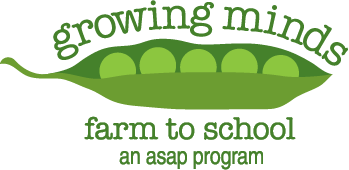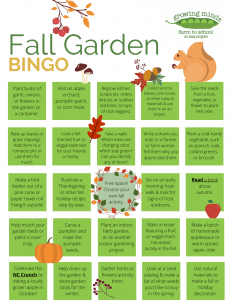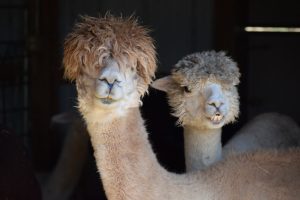This week’s theme is pumpkins. Our “Growing Minds Day by Day” educational resource lists are designed for families and educators.
Thanks to Halloween, October is the pumpkin’s month in the spotlight! Pumpkins are a round, ridged variety of winter squash. They’re members of the cucurbit plant family, along with melons, cucumbers, and summer squash. Pumpkins originated in North America in the regions that now comprise the Southern United States and Northern Mexico. They have been cultivated by indigenous North Americans for thousands of years. In our region, pumpkin seeds are planted in the early summer. The plants grow into large sprawling vines throughout the warm summer months, and pumpkins are harvested in the fall. In addition to being used for fall decor and carving, pumpkin flesh and seeds are edible and highly nutritious. Pumpkin is used to make baked goods as well as soups, stews, and other savory dishes. Use the resources below to teach kids all about pumpkins!
Books:
 The Runaway Pumpkin
The Runaway Pumpkin
A bumpin’ thumpin’ rhyming picture book about the delicious fate of a gigantic pumpkin on the run. When Buck, Billy, and their little sister Lil spy the biggest pumpkin they’ve ever seen, they can’t resist. Buck and Billy try to roll the pumpkin down the hill to show everyone, but it’s too big! Before they know it, it’s bumping and thumping and rolling down the hillside out of control. This Halloween treat by Kevin Lewis is perfect for kids and families. Watch a read aloud on YouTube.
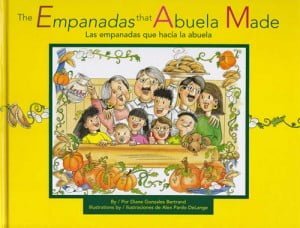 The Empanadas that Abuela Made / Las empanadas que hacía la abuela
The Empanadas that Abuela Made / Las empanadas que hacía la abuela
In this rhythmic story by Diane Gonzales Bertrand, told in both English and Spanish, children will learn the steps and ingredients to make Abuela’s pumpkin empanadas. It turns out that making empanadas is a whole family affair! An empanada recipe is included in this book, which is available for Asheville-based educators to check out from the Growing Minds lending library. Recommended for ages 4-8. Watch a read aloud on YouTube.
 How Many Seeds in a Pumpkin?
How Many Seeds in a Pumpkin?
Mr. Tiffin’s class is on a mission to see how many seeds are in three different sized pumpkins. They pull out all the seeds and count by twos, fives and tens to see which pumpkin has the most, and are surprised by what they discover. This book by Margaret McNamara is a fun way to introduce kids to estimation; they too can count how many seeds are in a pumpkin! This book is featured in our Pumpkin Exploration Lesson Plan, and is also available to check out from our lending library. Recommended for ages 3-7. Watch a read aloud on YouTube.
Find more books
Both of the books above are available for Asheville-based educators to check out from our lending library. Visit the Growing Minds’ farm to school literature database to discover more of our favorite fall-themed children’s books. Type “pumpkin” into the search bar to explore more of our favorite pumpkin stories.
Local Food Recipe:
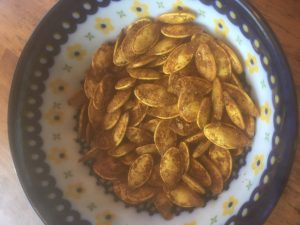 Planning on carving a jack-o-lantern this week in celebration of Halloween? Don’t throw away your pumpkin seeds! Pumpkin seeds can be baked into a tasty, crunchy fall treat. Pumpkin seeds are a healthy source of fiber, protein, and vitamins. They can be seasoned with a little salt before roasting, or you can toss them with a blend of dried spices and make up your own unique flavor profile!
Planning on carving a jack-o-lantern this week in celebration of Halloween? Don’t throw away your pumpkin seeds! Pumpkin seeds can be baked into a tasty, crunchy fall treat. Pumpkin seeds are a healthy source of fiber, protein, and vitamins. They can be seasoned with a little salt before roasting, or you can toss them with a blend of dried spices and make up your own unique flavor profile!
Roasted Pumpkin Seeds
Ingredients:
- Raw pumpkin seeds (scooped from inside a pumpkin)
- 1-2 Tbsp. olive oil or melted butter
- Salt
- Dried spices of your choice (ideas: black pepper, garlic powder, paprika, cinnamon, brown sugar, curry powder)
Directions:
- Preheat the oven to 350 °F.
- Rinse seeds to remove any pumpkin pulp. Dry the seeds on a clean cloth kitchen towel or paper towels.
- In a bowl, toss pumpkin seeds with a tablespoon or so of oil or melted butter, a pinch of salt, and a pinch of any spices you choose to use to season your seeds.
- Spread the coated seeds in a single layer on a baking sheet and roast for 20-30 minutes or until the seeds are golden brown. Stir the seeds a few times throughout baking.
Educational Resources:
- Pumpkin Exploration (preschool): Through a creative exploration of pumpkins, students gain a new understanding of this vegetable and all of its diverse uses. Students use a pumpkin seed activity to practice counting.
- Pumpkin Exploration (K-2): Introduce students to pumpkins and how they grow. Use a pumpkin seed activity to practice sorting and counting in 2s, 5s, and 10s.
- Fall Garden Bingo: Carving a pumpkin and roasting the seeds can earn kids a square on our fall bingo card! Find more activities that will help kids play this card here.
- Pumpkin Activity Sheet created by George Organics: activties, recipes & fun facts
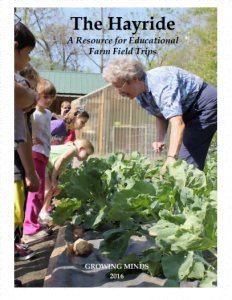 The Hayride: A Resource for Educational Farm Field Trips
The Hayride: A Resource for Educational Farm Field Trips
Are you planning a field trip or outing to a pumpkin patch, corn maze, or apple orchard this fall? This Growing Minds publication can be used by educators, parents, and caregivers to plan successful educational farm field trips. The resource contains tips for selecting a farm to visit and communicating with farmers, ideas for on-farm activities and classroom curriculum connections, and suggestions for what to bring on the field trip to ensure a memorable and successful visit. Use ASAP’s online Local Food Guide to find farms in the Appalachian Grown region that have pumpkin patches.
Activities:

Do pumpkins float?
Ask children what their predictions are and chart them. Fill buckets with water and see if each pumpkin floats. Ask children why they think it floats (it floats because it is hollow inside and filled with air like a balloon). You can also test if other fruits or vegetables will float; be sure to ask kids for their predictions before testing. Some fruits and vegetables to consider testing are apples, peppers, bananas, carrots, and zucchini.
Pumpkin Planters
Pumpkins can be carved, explored, baked, and even planted in! A single pumpkin can provide hours of fun for children. For a dynamic fall activity, follow the directions below to create a pumpkin planter.
Directions:
- Purchase two or three small pumpkins.
- Cut the tops off of the pumpkins. Leave the seeds inside the pumpkins.
- Fill the pumpkin cavities with soil.
- Water the pumpkins once a day for several weeks. The pumpkin seeds will sprout and you will be able to observe a new pumpkin plant (or several!) growing. You can plant the pumpkins in a large container indoors and watch them continue growing.
Sing a Song
Five little pumpkins sitting on a gate,
First one said, “Oh my, it’s getting late.”
Second one said, “There are witches in the air.”
Third one said, “I don’t care!”
Fourth one said, “Let’s run and run and run.”
Fifth one said, “I’m ready for some fun.”
Ooooooooo went the wind,
And out went the lights,
And the five little pumpkins
Rolled out of sight!
Meet Your Farmer Videos:
Do you know how to tell the difference between an alpaca and a llama? Find out by watching a video in our Meet Your Farmer web series. Meet Erin Greene, the farmer at Last Penny Farm Alpacas in Weaverville, NC, and her children, Jacob and Sadie. Learn about how Erin became a fiber farmer, find out what she enjoys about raising animals, and meet the adorable alpacas that call this farm home. After the interview, take a virtual farm tour led by junior farmers Jacob and Sadie. Visit the farm’s website to learn more about Last Penny Farm Alpacas.
—
That’s it for this week. Check back next week for new resources. Click here to access Day by Day resources from past weeks. If you didn’t find what you’re looking for here, please visit our Lesson Plans page.
